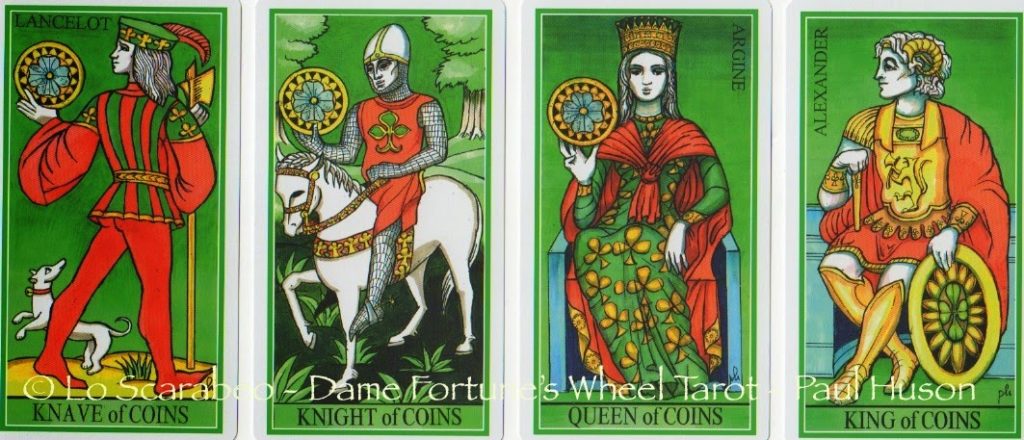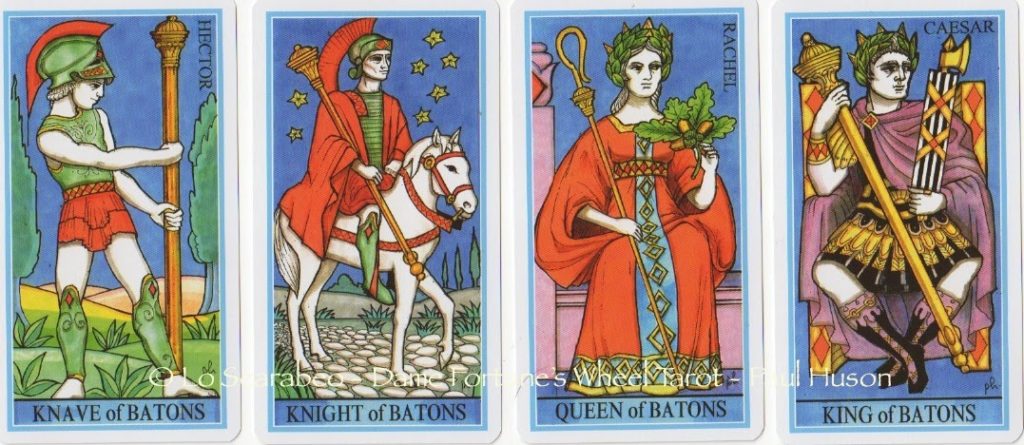Meet the Family | Dame Fortune’s Tarot Wheel
A while back I was enthusing about this Dame Fortune deck because it had a ready-made significator which absolves you of appropriating another Tarot card to use as the significator for your client. At the time, I said that the Courts of the deck were worth a post on their own, so here they are.
A year later.
What can I say? I’m in a Pentacle-type sloooooooow state of mind 🙂
I’ve written a post on the names associated with these Tarot cards, which you can read here.
Dame Fortune’s Tarot Wheel was created by Paul Huson, the author of the excellent Tarot books, The Mystical Origins of The Tarot and The Devil’s Picturebook.
Huson favours the tarot as it was, prior to the meddlings of those pesky kids from The Golden Dawn and draws his inspiration directly from Etteilla’s Tarot of the 1700s.
Who was this Etteilla person and why are we interested in him? well, that will be the subject of another post!
Anyhoo, let’s meet the courts who have been waiting patiently for a year! Here’s my take on Dame Fortune’s courts 😀
The Swords family are largely in orange with a contrast of bright blue. They all sport spades on their regalia in some way or another, linking to their playing card suit.
The Knave, Ogier, stands attentive while the nameless Knight’s white horse rears up – terribly chivalrous-looking, isn’t he?
The Queen is clearly Pallas Athene – the Greek goddess of wisdom. I love the blood-like slashes of red inside her cloak – reminding us that this is a woman not to be messed with! She looks directly towards the Knight – and he to her. Looks quite an interesting relationship there…..
I did read in Stuart Kaplan’s Tarot Encyclopedia that this name ‘Athene’ might actually refer to the martial Joan of Arc.
Our elderly King of Swords is the Biblical hero, King David. I love the Star of David on the throne and the inclusion of the harp, to remind us of the Psalms he wrote. You can see the spade insignia on his armour and over his heart.
The Cups are all in a deep watery blue, coupled with green and red. The characters in this suit have no weapons nor armour (other than the Queen, Judith) Hearts are the playing card associations for this crowd and you can see this in all of the cards – La Hire’s leggings, the Knight’s jacket, in the robes of the King and the drapes that surround the Queen, as well as inscribed on each of their Cups.
The Knave stands before a huge display of white lilies and his green scarf flows like water from his shoulder to his open Cup. The nameless Knight is the least warlike of the four Knights – bare headed and weaponless; very much a character from a romantic tale. Queen Judith’s cup has a lid on it – perhaps she keeps something of herself under wraps? It’s marvellous that she’s depicted with a sword (she decapitated the General, Holofernes, in the Bible tale).
The King of Cups, Charlemagne, seems to be standing (the only King to be depicted thus) and is not depicted in armour – so he looks more like a priest than a King, don’t you think?
The suit of Wands is depicted in blue and diamonds are their playing card symbol.
The valiant Trojan Hector in his armour stands as Knave of Batons – his pose reminiscent of the RWS Page of Wands, I feel. What does his baton remind you of? For me it is something quite playful, like a tent pole, rather than a weapon.
The Knight rides forth down a cobbled path on his white horse looking much calmer than we would associate with a Golden Dawn Knight of Wands.
The Queen is patient Rachel who waited 14 long years for Jacob to be able to wed her, her robe decorated with diamonds and clutching a spray of oak leaves and acorns (strength? endurance?). Her baton is a shepherd’s crook. For when Jacob encounters her for the first time in their Bible story, Rachel is tending sheep. Caesar represents the King of Batons and has diamonds on his throne and carries the ‘fasces’ bundle that symbolises the power of the Roman senate.
So what do you think of these courts? Do you like the names? Do you like these characters – do their historical/mythical characters feed into your understanding of the cards as contemporary courts?





12 Comments
Rae della Luna · 24th November 2014 at 10:08 pm
Had the book, and bought the deck due to this posting. Echoing Jamie's comment, thank you! Btw, there is an extended LWB in PDF format that Paul Huson links to on his web profile.
Alison Cross · 25th November 2014 at 3:45 pm
I wasn't sure whether it was a different book to the one that arrived with the deck, Rae. Thank you so much for the heads-up on this, I'll go and download it!
Rae della Luna · 27th November 2014 at 2:18 pm
Welcome 🙂
Jamie · 20th November 2014 at 1:33 am
Alison!
I bought the deck AND the book as a result of reading this excellent post. Thanks for the heads up.
jme
Alison Cross · 25th November 2014 at 3:43 pm
oh, good news! I hope that you enjoy the deck, Jamie!
Inner Whispers · 11th November 2014 at 8:36 am
I can't say I see the Queen of Batons as a particularly patient woman! Still, interesting to add this layer to the Courts 🙂
Alison Cross · 11th November 2014 at 11:03 am
No, she's probably not – although I would say that Rachel was. But perhaps Rachel was part of the cunning plan that enticed Jacob to work for 14 years! THAT sounds a bit more like our Queen of Wands 😀
Inner Whispers · 13th November 2014 at 2:39 pm
Ha ha, yes, it certainly does 😉
Joanne Sprott · 10th November 2014 at 3:02 pm
Really engaging post and very interesting pre-GD interpretation by the creator. I'd heard of some of these mythical/historical playing card associations for the courts (probably from you, Ali); all nicely and very colorfully put together here.
And not sure about Argine myself. Wonder if she was anyone in particular?
Alison Cross · 10th November 2014 at 3:21 pm
In Kaplan's Tarot Encyclopedia, there was a suggestion that she represented Charles VII's wife Marie of Anjou with another of the Queens representing his mistress Agnes Sorel. Given that The Maid of Orleans herself (Athene) and one of her sidekicks are in the deck too – perhaps those Royal connections WERE common associations by those using the cards. Sort of like the competitive TRUMP cards as played with by kids the world over?
Alison Cross · 10th November 2014 at 5:49 pm
You can also read this info – and plenty more besides – in Paul Huson's Mystical Origins of the Tarot is a damned fine resource and worth investing in!
Ania · 10th November 2014 at 10:36 am
What incredibly vibrant cards. It's nice to know that the courts have a story, rather than being just generic representations.
And I had no idea Lancelot was so flexible – his head-turning skills would put an owl to shame LOL
Comments are closed.